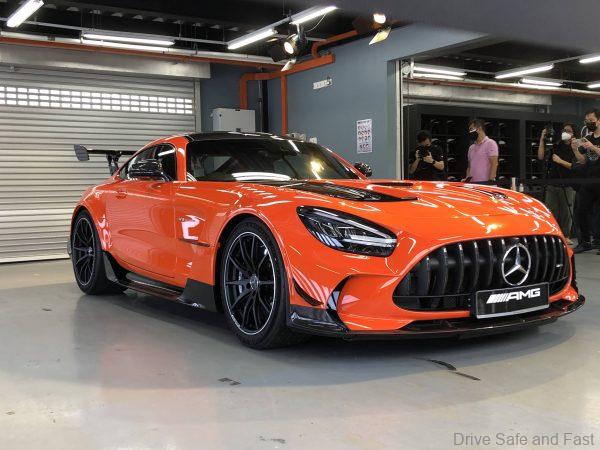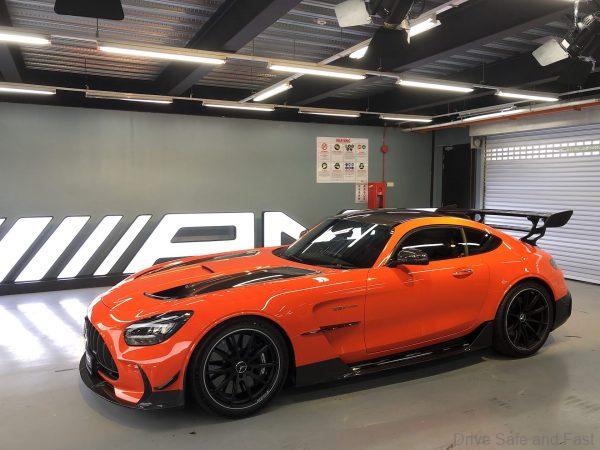Mercedes AMG GT Black Series Arrives In Malaysia At RM2.9 Million
This AMG GT Black Series is the fastest Benz you can buy right now new.
Mercedes-Benz Malaysia has just given the Malaysian motoring media and some 140 selected AMG car owners a first close look at the AMG GT Black Series at a location it will call ‘home’.
Sepang race circuit is where this very fast Mercedes supercar will feel right at home and this is the first of just 13 units to be sold in Malaysia. Priced from RM2.9 million with all taxes and duties paid in full, this car comes with a hand-built 3,982cc V8 engine that produces 730 horsepower and a stomping 800Nm of torque from just 2,000rpm.


This above numbers allows for a standstill to 100km/h acceleration time of just 3.2 seconds and a top speed of 325km/h when you find enough tarmac to test it. This 730 hp monster AMG was the fastest production car around the Nürburgring Nordschleife, with a time of 6:43,616 when it was launched in Europe.
In late September 2020 this Black Series AMG Merc was over a second clear from the previous production car record holder, the Lamborghini Aventador SVJ, and is more than 4 seconds faster than a Porsche 911 (991) GT2 RS, which now holds the record for the third faster production car to lap the ‘Ring. It is still however still a ways off the overall Nurburgring lap record of 5:19.546, set by the Porsche 919 Hybrid Evo.
Working with a AMG built Speed-shift DCT 7G gearbox it is said to be a real joy to drive even in the city.
This very special car is taking center stage at the Mercedes-AMG Track Day, which is a performance driving experience for customers and prospects of Mercedes-Benz cars.


PRESS RELEASE: At Mercedes-AMG, the Black Series has been synonymous with a very special type of car since 2006: uncompromisingly sporty, with an expressive design and the most consistent technology transfer from motorsport to series production. Black Series models are exclusive automotive rarities. They have not been developed to gather dust in collectors’ garages, but for high-speed use on race tracks, despite being approved for roads. The AMG GT Black Series represents a new highlight in this tradition: It is the most powerful Mercedes-AMG with a V8 series engine and can thus be individually adapted to the special conditions of various race tracks in a more versatile way than ever before.
In order to emphasise the redefinition of the super sports car, the engine specialists in Affalterbach have once again extensively further developed the tried-and-tested 4.0-litre V8 biturbo unit – in addition to it already being renowned for excellent driveability, power delivery and torque progression.
The specifications were clear: Significantly more power than the previous flagship model of the AMG GT family, an even more agile throttle response, maximum torque – all of which meant that a radical change was needed in the form of a new, ‘flat’ crankshaft.
Different designs of V8 engines
The design of a V8 engine gives designers plenty of room to play with in one key element: the crank arrangement on the crankshaft. This influences the characteristics of the engine. There are usually two variants in V8 engines: the ‘cross plane’ where the crankpins of the four pairs of cylinders are at 90-degree angles to each other, which AMG has used in all previous V8 engines, or the ‘flat crankshaft’, where all crankpins are on the same plane with a 180-degree offset (‘flat plane’).
If you look at the front of a cross-plane crankshaft, you will be able to identify the cross that gives it its name. The benefits of these crankshafts are superb smoothness and high torque at low rotational speeds.
The characteristic sound is another hallmark feature of the cross-plane V8 engine. In order to make optimal use of the displacement and therefore the performance potential in the case of the 4.0-litre V8 biturbo engine, the AMG engineers have essentially moved the exhaust side into the hot internal V of the two cylinder banks in the V8 engine.
Uniformly oscillating gas columns for even more power
Another way of increasing performance is by using a ‘flat’ crankshaft. In the flat-plane V8 engine, it looks like an inline four-cylinder model – except for the wider crankpins, which have two connecting rods each in the V8. Ignition in the flat-plane V8 jumps from one cylinder bank to the next, which further improves the gas cycle.
The characteristic firing order with a 180-degree crankshaft angle offset is 1-8-2-7 4-5-3-6. This creates uniformly oscillating gas columns in the exhaust tract and on the intake side, whose resonance can easily be used to increase performance. The greatest advantage is an even more agile throttle response.
The most powerful V8 series engine from Mercedes-AMG
The new AMG GT Black Series engine is based on the AMG 4.0-litre V8 biturbo engine with dry sump lubrication, but it has been given the new internal code M178 LS2 due to the numerous modifications. It achieves 537 kW (730 hp) at 6700-6900 rpm and delivers a maximum torque of 800 Nm at 2000-6000 rpm. New camshafts and exhaust manifolds are adapted to the new firing order and improve the gas cycle further.
Both twin scroll exhaust turbochargers are mounted in anti-friction bearings, as in the top-of-the-range four-door AMG GT Coupé, which optimises their throttle response even further. However, in the Black Series, the turbochargers have been given a larger compressor wheel, meaning that both can deliver a total of 1100 kg air per hour. By way of comparison: The figure is 900 kg/h for the AMG GT R. 7000 rpm is not critical as a continuous speed, the speed is limited at 7200 rpm.
0-200 km/h in under nine seconds
What does the engine do for the AMG GT Black Series? It gives it a completely independent character, which is not only reflected in the type of power delivery, but also in its very particular sound pattern. And it enables highly impressive driving performance: the two-door vehicle shoots from 0 to 100 km/h in 3.2 seconds, and to 200 km/h in under nine seconds. The top speed is 325 km/h, although only on cordoned-off racetracks.
Modified AMG SPEEDSHIFT DCT 7G transmission
Power is transmitted to the rear wheels via the seven-speed AMG SPEEDSHIFT DCT 7G dual clutch transmission, which is located on the rear axle in a transaxle arrangement for optimal weight distribution, as is the case for all AMG GT models. It has been modified for use in the AMG GT Black Series and adapted to the increased torque of 800 Nm. The previous limits governing shift performance and response time have been extended, making them more suitable for racetracks.
This all adds up to very different handling characteristics, as not only is the accelerator and engine response more agile – the drive programs, start-up characteristics and gear changes are, too. The Race Start function is also now even more impressive, thanks to the increased starting revs, the more sensitive wheel slip control and the sports tyres fit for the racetrack. Furthermore, the transmission cooling has been adapted to the tougher requirements, and the transmission ratios have also been slightly modified.
The ‘torque tube’ creates the connection between the engine and the transmission. It is made of carbon fibre and, at just 13.9 kilograms, is around 40 percent lighter than its already weight-optimised aluminium counterpart in the AMG GT. As a structural component of the transaxle drivetrain, it creates an extremely flexurally and torsionally stiff connection between the engine and the transmission.
Sophisticated aerodynamics for incredibly high driving dynamics
The sophisticated aerodynamics not only make a significant contribution to high driving dynamics and stability on fast circuits. As with the AMG GT R and AMG GT R PRO, aerodynamics experts and designers have worked in close collaboration, as ‘form follows function’ applies more than ever in the case of the Black Series.
The similarity to the AMG GT3 and AMG GT4 racing cars is visually and technically stronger than ever before. It starts already with the new, significantly larger cooling air inlet grille, which stems directly from the AMG GT3 racing car. The radiator trim has vertical struts in dark chrome. Because the wheel arch coolers are now also supplied with air directly via the central intake, there is no longer a need for the two additional outer air inlets in the front apron. Sickle-shaped flics optimise the flow of air here, which not only increases downforce at the front axle, but also improves brake cooling.
Bonnet with two large exhaust air openings improves aero-performance
Another direct derivative from motorsport is the new carbon-fibre bonnet, with two large exhaust air outlets made from black-finished carbon surfaces. The large outlets guide the warm air, which is fed from the diagonally positioned cooling pack, out of the engine compartment. This technology is also directly derived from motorsport and increases the overall downforce. At the same time, the air resistance is reduced, and the air mass flow for cooling the engine is optimised. The air is also specifically guided around the A-pillars and side windows to the rear, where it increases the efficiency of the new rear aerofoil concept.
The seamlessly integrated louvres (air slots), with five fins in the body colour and exhaust air openings behind the wheels in the front carbon-fibre wings, help to increase downforce at the front axle by means of effective wheel arch ventilation. The air flowing around the vehicle is also optimised by the new, significantly larger and wider side sill panels with black carbon-fibre elements, which merge into vertical blades at the front and rear. Additional cooling air ducts are integrated into the side sill panels for brake cooling at the rear axle.
Two-stage rear aerofoil concept
The rear view is characterised by the new rear apron with a large diffuser, two rounded twin tailpipe trims on the outside left and right, side wheel arch ventilation, and the innovative rear aerofoil concept. Both aerofoil blades are made from carbon fibre, can be mechanically adjusted and therefore adapted to various track conditions. The second, lower positioned blade was made particularly small and narrow because this is ideal for the air arriving from the front of the car. On delivery both aerofoil blades are set flat. The light yet robust carbon-fibre aerofoil supports, painted matt black and specially designed based on extensive simulations also increase aerodynamic efficiency. They are bolted to the carbon-fibre tailgate, which is also black.
Another fascinating detail: the movable flap in the upper blade. This active aerodynamic element is electronically adjusted by 20 degrees, to suit the driving situation and selected AMG DYNAMICS mode, and thus influences on the longitudinal and transverse dynamics. In a flat position, it reduces the air resistance, to help reach the top speed more quickly. In the inclined position, the flap improves braking performance and cornering stability thanks to increased downforce at the rear axle.
Various actuation strategies were developed for the active aerodynamics element, depending on the AMG DYNAMIC SELECT drive program chosen and the AMG DYNAMICS levels Basic, Advanced, Pro or Master. Some of these strategies also involve driving dynamics recognition: when dynamics are detected (such as sharp braking, accelerating, cornering, steering) the flap is extended for as long as dynamics continue. After that there is a brief hold time of three and a half seconds, and the flap retracts again.
Almost full panelling on the underbody
The detailed aerodynamic work also includes the now almost fully panelled underbody, which must not only meet aerodynamic requirements, but thermal ones as well (heat dissipation). The flat underbody is equipped with specially designed longitudinal fins. These air channellers have been meticulously optimised to ensure optimal air flow to the rear diffuser. The entire package accelerates air flow, significantly increasing downforce. All measures are coordinated and interact with the new rear aerofoil concept. The result of all these measures is a downforce level of well over 400 kilograms at 250 km/h.
Light and stabile carbon fibre used in a versatile way
The lightweight carbon-fibre roof, with a sunken centre, as well as the carbon-fibre tailgate with small spoiler lip and larger rear windscreen made from lightweight thin glass, are all key components of the ‘intelligent material mix’ and ‘lightweight construction’. Moving to the front of the car, the glass used to make the laminated glass windscreen is likewise thin and therefore light in weight. The coiled carbon-fibre transmission mount is another exclusive Black Series component.
The standard ceramic high-performance compound brake system with black painted brake callipers and white lettering is also characterised by low weight and high performance. Special brake pads and discs together with modified brake cooling guarantee optimal and non-fading deceleration as well as high-precision brake-application options. The standard light-alloy forged wheels also contribute to weight reduction.
AMG coil-over suspension with adaptive adjustable damping
The double wishbone concept locates the wheel with high camber and toe-in stability. This enables high cornering speeds and gives the driver optimum road feel when cornering at the extreme limits. Wishbones, steering knuckles and hub carriers on the front and rear axle are made entirely from forged aluminium in order to reduce the unsprung masses. The spherical bearings on the upper and lower wishbones of the rear axle come straight from motorsport. Their design means they have no play, which means toe-in and camber do not change even under high loads. The AMG GT Black Series therefore allows for precise steering, gives clear steering feedback and thus delivers better cornering performance, too.
As with the AMG GT R, an AMG coil-over suspension with adjustable spring preload is used in the Black Series, with technology which is adapted to meet the specific requirements for extreme race track use with high damping forces. Ex factory a vehicle height suitable for popular race tracks such as the Hockenheimring, Lausitzring or Nürburgring is set – where the kerbs are also driven over for fast lap times. In order to reach a lower vehicle centre of gravity for even higher transverse acceleration on flat stretches, the Black Series can be lowered by up to 10 millimetres. The coil-over suspension offers yet another advantage which committed sports drivers value greatly: the wheel load distribution can be individually adapted for every wheel and thus optimise handling.
Carbon fibre also reduces the suspension weight
The front axle is fitted with a dual adjustable torsion bar made of lightweight carbon fibre. The car has this short (i.e. firm) connection as its default setting. Its counterpart at the rear axle is made of steel, is triple adjustable, and saves weight thanks to its hollow tube design. From the default “central” position, it can be adjusted to one level harder (short connection) or softer (long connection). The carbon-fibre shear panel in the rear underbody supports the high driving precision. This lightweight and rigid element stiffens the rear-end structure and as a result makes the bodyshell even more stable. The electronically controlled dynamic engine and transmission mounts were also retuned to further increase the agility and deliver high-precision response and clear feedback.
Grip to the power of nine: AMG TRACTION CONTROL
For use on cordoned-off racetracks in ESP OFF mode, the AMG TRACTION CONTROL enables the driver to get individual support for controlling the immense power of the Black Series – and without any ESP brake intervention whatsoever. The level of support can be fine-tuned, providing the ideal level of assistance for each driver and each track situation. The AMG TRACTION CONTROL has been extensively tailored to meet the requirements of the new Black Series and allows preselection of one of nine slip settings on the live rear axle. Control is exclusively via corresponding maps in the engine electronics and without any intervention in the ESP system, as is also the case with the GT3 racing car.
The AMG development has a major advantage over conventional systems in that it anticipates situations with the help of a friction coefficient evaluator and other data processed by a control unit within a fraction of a second. The maximum permissible drive slip on the rear wheels is calculated depending on the selected AMG TRACTION CONTROL level. When the wheels reach this level of slip during acceleration, the traction control modulates the engine output so that this level is not exceeded and the vehicle continues accelerating with this specified slip.
Orange as an exclusive contrasting colour
The interior design emphasises the pole position of the AMG GT Black Series: Exclusive nappa leather is combined with sporty DINAMICA microfibre in black with orange contrasting topstitching. The instrument panel and the newly designed lightweight door panels, which are now equipped with loop pull handles instead of conventional handles, are trimmed in black DINAMICA microfibre.
Displays with AMG-specific graphics
The AMG GT Black Series features the fully digital instrument displays from the AMG GT family with an instrument cluster measuring 12.3 inches in front of the driver, and a 10.25-inch multimedia monitor on the centre console. The instrument cluster offers different designs with the three AMG-specific display styles: ‘Classic’, ‘Sporty’ or ‘Supersport’. The ‘Supersport’ view with a central rev counter features extensive additional information, such as a prompt to shift up in manual transmission mode, the ‘shift light’. The visualisations on the multimedia display enable further vehicle functions to be experienced, e.g. with animated presentations of the driving assistance, vehicle and communication systems.
At your fingertips: display buttons in the centre console
The innovative, coloured display buttons in the V-shaped central console integrate the display and control of transmission logic, suspension, ESP, exhaust system, rear aerofoil flap and start/stop function. The TFT display buttons use intuitively comprehensible symbols to show their functions and are easy to operate with just a small tap of the finger. As they still have a mechanical pressure point, they can also be operated whilst wearing racing gloves. The display buttons are supplemented by the two rocker switches for the drive programs and volume control of the audio system.
Control in an instant: the AMG Performance steering wheel
The AMG Performance steering wheel is also adopted from the AMG GT family. It is characterised by its sporty design, a flattened bottom section with a heavily contoured rim and intuitive operation. The steering wheel rim is fully trimmed in DINAMICA microfibre, while the steering wheel badge exclusively features the Black Series lettering, along with the AMG logo. The aluminium steering wheel shift paddles for manual gear changes allow even sportier driving. The integrated Touch Control buttons can be used to control the instrument cluster and the multimedia display by means of horizontal and vertical finger swipes.
As standard, the AMG steering wheel buttons also have a round controller with an integrated display, as well as two vertically positioned coloured display buttons with switches. The AMG drive programs can be activated using the right controller. The selected setting is shown on the colour LCD display directly integrated in the controller.
The Black Series history: living tradition
Again and again Mercedes-AMG develops especially exclusive vehicles for enthusiasts under the label Black Series High-Performance Cars. It all started in 2006 with the SLK 55 AMG Black Series. The AMG 5.5-litre V8 engine in the puristic two-seater entices drivers with its maximum output of 294 kW (400 hp) and 520 newton-metre torque.
With an equally spectacular design, current technology transfer from motorsport and vehicle dynamics at the highest level, four years later, as of 2012, the C 63 AMG Coupé Black embodied the AMG brand pledge Driving Performance at its finest. With a maximum power output of 380 kW (517 hp) and 620 newton metres of maximum torque, the high-performance vehicle is the most powerful C-Class model to date. Acceleration from zero to 100 km/h took 4.2 seconds.
The adjustable coil-over suspension was also a contributing factor in the exclusive driving pleasure, as was the high-performance compound braking system and the functional standard equipment level. To enhance the driving dynamics even further, the Track Package with competition tyres and active cooling of the rear differential gear, the AMG Aerodynamics Package with flics, front splitter and adjustable carbon rear aerofoil were available.
Inspired by the Customer Sport SLS AMG GT3 racing car, the SLS AMG Black Series thrilled in 2013 with its breathtaking design, outstanding vehicle dynamics and systematic lightweight construction. The 6.3-litre V8 engine delivers 464 kW (631 hp) at 7400 rpm 44 kW (60 hp) more than the SLS AMG. Acceleration from zero to 100 km/h is completed in 3.6 seconds, the top speed reached at 315 km/h.